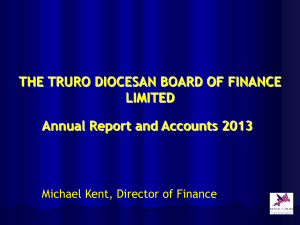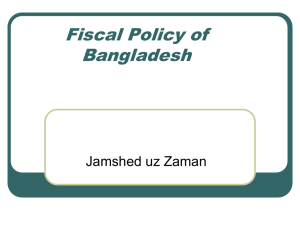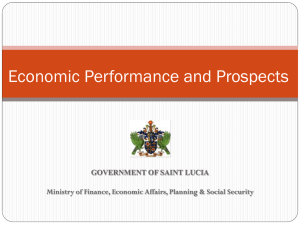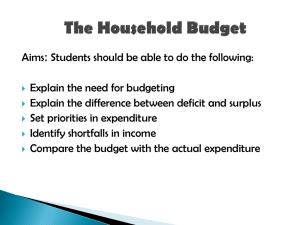To view full message
advertisement
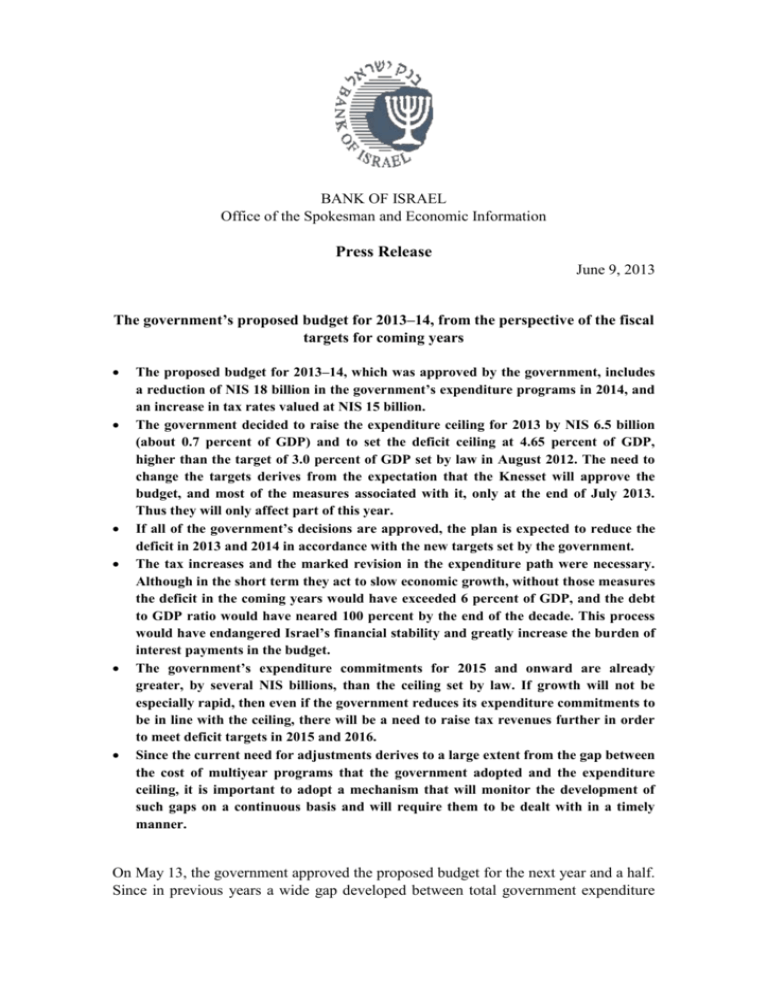
BANK OF ISRAEL Office of the Spokesman and Economic Information Press Release June 9, 2013 The government’s proposed budget for 2013–14, from the perspective of the fiscal targets for coming years The proposed budget for 2013–14, which was approved by the government, includes a reduction of NIS 18 billion in the government’s expenditure programs in 2014, and an increase in tax rates valued at NIS 15 billion. The government decided to raise the expenditure ceiling for 2013 by NIS 6.5 billion (about 0.7 percent of GDP) and to set the deficit ceiling at 4.65 percent of GDP, higher than the target of 3.0 percent of GDP set by law in August 2012. The need to change the targets derives from the expectation that the Knesset will approve the budget, and most of the measures associated with it, only at the end of July 2013. Thus they will only affect part of this year. If all of the government’s decisions are approved, the plan is expected to reduce the deficit in 2013 and 2014 in accordance with the new targets set by the government. The tax increases and the marked revision in the expenditure path were necessary. Although in the short term they act to slow economic growth, without those measures the deficit in the coming years would have exceeded 6 percent of GDP, and the debt to GDP ratio would have neared 100 percent by the end of the decade. This process would have endangered Israel’s financial stability and greatly increase the burden of interest payments in the budget. The government’s expenditure commitments for 2015 and onward are already greater, by several NIS billions, than the ceiling set by law. If growth will not be especially rapid, then even if the government reduces its expenditure commitments to be in line with the ceiling, there will be a need to raise tax revenues further in order to meet deficit targets in 2015 and 2016. Since the current need for adjustments derives to a large extent from the gap between the cost of multiyear programs that the government adopted and the expenditure ceiling, it is important to adopt a mechanism that will monitor the development of such gaps on a continuous basis and will require them to be dealt with in a timely manner. On May 13, the government approved the proposed budget for the next year and a half. Since in previous years a wide gap developed between total government expenditure commitments and the maximum annual expenditure allowed under the expenditure rule, and since the expected deficit in 2013 and 2014 was considerably greater than the deficit targets set by law, the government was forced to curtail expenditure programs and raise taxes by a total of over NIS 30 billion, which is about 3 percent of GDP (Figure 1). In 2013, due to the late approval of measures in the economic plan, the government was forced to change the budget targets: the deficit ceiling was raised from 3 percent of GDP—the target set in August 2012—to 4.65 percent of GDP, and the government decided to deviate by NIS 6.5 billion, on a one-time basis, from the expenditure ceiling set in law. The changes in the program are expected to raise, in 2014, the share of tax revenue in GDP by more than 1 percentage point compared with 2013. The revisions are also projected to reduce the share of public expenditure in GDP by almost 2 percentage points, compared with that which was expected beforehand based on programs adopted by the government. However, the expenditure plans taken on by the government for 2013 and 2014 were so large, that despite the sharp reduction in those plans, the share of public expenditure in GDP in 2014 is expected to be similar to its share in 2012, about 43.5 percent of GDP. Based on Research Department estimates, and given the current assessments regarding the macroeconomic environment expected in coming years, full implementation of the measures included in the plan will allow the government to stay within the expenditure ceiling and meet the deficit targets set for 2013 and 2014, despite the fact that in the short term these measures are expected to slow GDP growth. However, since the margin for meeting the targets is small, if significant components of the plan are not approved, or if there will be an additional deterioration in the macroeconomic environment, attainment of the targets would be at risk. The fiscal adjustment in the approved budget proposal is expected to moderate growth in 2014 by about 0.7 percent compared with estimates made before the plan. Despite this cost, a plan to reduce the deficit was necessary, since without it the deficit was projected to reach almost 6 percent of GDP in 2014 (Figure 1), and to continue to increase in the following years. A deficit of this level would have rapidly increased the debt to GDP ratio, and by the end of the decade it would have neared 100 percent of GDP (the black line in Figure 2). A deficit level like that, especially given the relatively good state of the Israeli economy and after the deficit target was already significantly raised in August 2012, would have increased the probability of a financial crisis—the medium term outcome of which could be considerably worse than the current budget’s effect on growth. Furthermore, the increased debt and interest rate which the government pays on its loans, would have raised, over time, the government’s interest expenditures, which are already high by international comparison, and would have curbed the sources available to it to provide public services or support for various population segments. An analysis of the expected expenditures in 2015 based on the plans approved by the government, shows that spending is around NIS 6 billion beyond the expenditure ceiling for that year. This gap derives from the one-off nature of a sizable portion of the steps adopted by the government to reduce expenditure in 2014, as well as from the agreed upon increase in the defense budget. Since there is another year and a half until the beginning of budget year 2015, this gap means that in the coming year and a half, the government will not be able to decide on new expenditures without, at the same time, either reducing other expenditures or placing at risk the adherence to the expenditure ceiling. The challenge facing the government is not only reflected in expenditure. Assuming that the growth rate between 2013–20 averages 3.2 percent, then even if the government makes the adjustments necessary to stay within the expenditure ceiling in 2015, the projected deficit in 2015—and even more so in the years following—is expected to be above the deficit targets set in law. While the deficit targets decline gradually to 2 percent of GDP in 2016, the deficit without an additional increase in tax rates is expected to stabilize at a level of around 3 percent of GDP until 2018 (the blue line in Figure 3). In order to stay within the deficit ceiling in 2015 and 2016 there will be a need for additional revenues of about NIS 4 billion (0.4 percent of GDP) in 2015 and an additional NIS 7 billion (0.5 percent of GDP) in 2016. Such a decline in the deficit, in accordance with the targets set by law (the green line in Figure 3), will allow the debt to GDP ratio to return to a declining path. In contrast, if the government will increase its expenditure in accordance with the existing plans (the costs of which, as noted, are above the ceiling), and does not increase tax rates, the deficit is expected to stabilize at a rate of 3.5–4 percent of GDP (the black line in Figure 3), and the debt to GDP ratio will increase moderately but consistently. A major factor contributing to the size of the fiscal problem with which the government has to deal now, and which threatens meeting the expenditure rule in 2015–16, is the lack of monitoring of the gap between the cost of programs approved by the government in recent years and the expenditure ceiling set by the fiscal rule. This gap has grown wider as the government adopted additional plans in elementary and high school education, the academic institutions, as well as infrastructure, health, and other areas. In light of the risk that developed this year to the credibility of fiscal policy, which forced the adjustments, it is important that the government quickly adopt an effective system to monitor its expenditures for coming years in order to prevent a repeat of the process which led to the current problem. This is particularly the case in light of the commitments already accrued for 2015. A system like that would follow government commitments for coming years and require immediate handling of developing deviations from the expenditure ceiling set in law. It would contribute considerably to the credibility of the government’s commitment to its fiscal goals and help reduce the repeated deviations from them.
